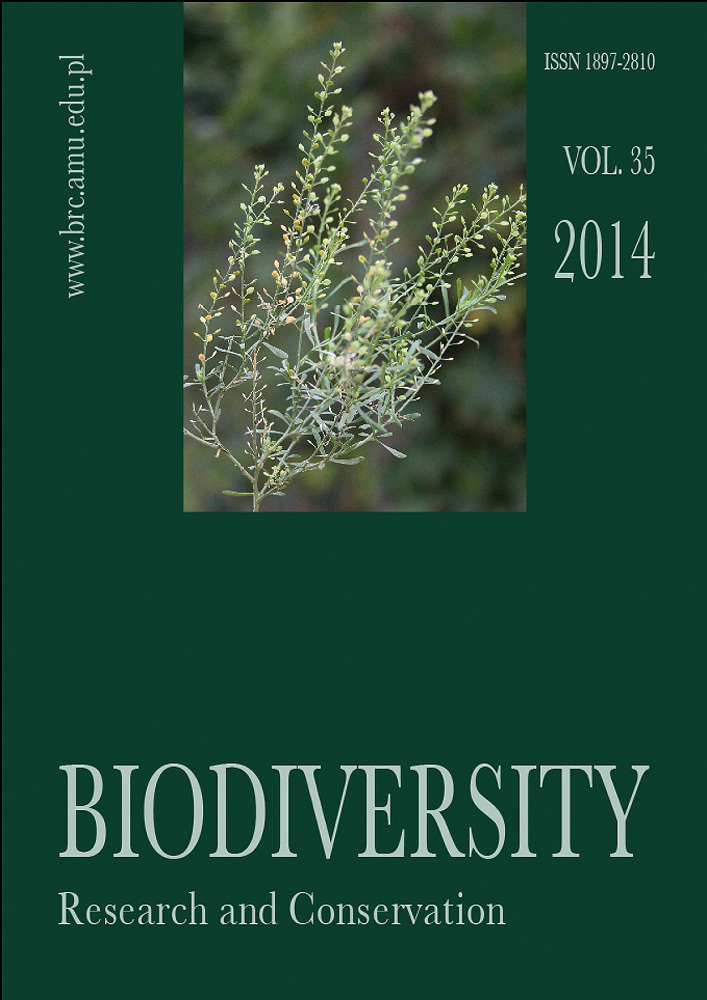Abstract
Geranio phaei-Urticetum dioicae, a poorly known association of nitrophilous outskirts communities was characterized based on 16 phytosociological relevés. Its ecological requirements and distribution in Pomerania and Poland are presented. A new subassociations of the Geranio phaei-Urticetum dioicae allietosum ursini have been distinguished on the basis of differing species composition. Edaphic and phytocenotic conditions of the population were specified. Association is found in mineral soil of acid reaction abundant with nitrogen and phosphorus, and as to its quantity it belongs to less numerous ones at Pomerania.
References
Balcerkiewicz S. 1978. Vegetation of Polana Chochołowska (Chochołowska Clearing) in the West Tatras. In: T. Wojterski (ed.). Guide to the Polish International Excursion 1-20 June 1978. Uniwersytet im. Adama Mickiewicza w Poznaniu. Ser. Biologia 11: 355-381.
Brzeg A. 1989. A systematic survey of ‘saum’-communities found and possibly occurring in Poland. Fragm. Flor. Geobot. 34: 385-425
Bednarek R., Dziadowiec H., Pokojska U. & Prusinkiewicz Z. 2005. Badania ekologiczno-gleboznawcze. 344 pp. PWN, Warszawa.
Hadač E., Bŕezina P., Ježek V., Kubička J., Hadačová V. &Vondráček M. 1969. Die Pflanzengesellschaften des Tales ‘Dolina Siedmich Prameńov’ in der Belaer Tatra. Vegetacia ČSSR B2, Vydavatelstvo Slovenskej Akademie Vied, Bratislava.
Hennekens S. M. & Schaminée J. H. J. 2001. TURBOVEG, a comprehensive database management system for vegetation data. J. Veg. Sci. 12: 1-589.
Kondracki J. 2004. Geografia regionalna Polski. 441 pp. Wyd. Nauk. PWN, Warszawa.
Matuszkiewicz J. M. 1993. Krajobrazy roślinne i regiony geobotaniczne Polski. IGiPZ PAN Prace Geograf. 158: 5-107.
Matuszkiewicz W. 2001. Przewodnik do oznaczania zbiorowisk roślinnych Polski. In: J. B. Faliński (ed.). Vademecum Geobotanicum, 3, 537 pp. Wyd. Nauk. PWN, Warszawa.
Mirek Z., Piękoś-Mirkowa H., Zając A. & Zając M. 2002. Flowering plants and pteridophytes of Poland. A checklist. In: Z. Mirek (ed.). Biodiversity of Poland, 1, 442 pp. W. Szafer Institute of Botany, Polish Academy of Sciences, Kraków.
Mucina L. 1993. Galio-Urticetea. In: L. Mucina, G. Grabherr & T. Ell mauer (eds), Die Pflanzengesellschaften Österreichs. Teil I. Anthropogene Vegetation, pp. 203-251. Gustav Fischer Verlag, Jena-Stuttgart-New York.
Nowosielski O. 1974. Metody oznaczania potrzeb nawożenia. 720 pp. PWRiL, Warszawa.
Ochyra R., Żarnowiec J. & Bednarek-Ochyra H. 2003. Census Catalogue of Polish Mosses. In: Z. Mirek (ed.). Biodiversity of Poland, 3, 372 pp. Polish Academy of Sciences, Institute of Botany, Kraków.
Pender K. & Rybałtowska Z. 1995. Vegetation of reservation ‘Beech forest at Skarszyn’. Acta Univ. Wratislav., Prace Bot. 62: 79-99.
Pender K. & Macicka-Pawlik T. 1996. Deciduous forests of the Lower subalpine zone in the midst of rocky-gates in the Pośna Valley of Stołowe Mountains. Acta Univ. Wratislav., Prace Bot. 70: 21-46.
Podani J. 1993. Syn-Tax - pc. Computer Programs for Multivare Data Analysis in Ecology and Systematics. Version 5.0. User’s Giude. Scientia Publishing, Budapest, pp. 351.
Ratyńska H., Wojterska M. & Brzeg A. 2010. Multimedialna encyklopedia zbiorowisk roślinnych Polski. Narodowy Fundusz Ochrony Środowiska i Gospodarki Wodnej w Warszawie, CD 1-2.
Świerkosz K., Dajdok Z. & Szczęśniak E. 2002. The association Geranio phaei-Urticetum dioicae in southwest Poland. Polish Botanical Journal 47(1): 53-66.
Wojterska M. 1990. Mezofilne zbiorowiska zaroślowe Wielkopolski. PTPN, Prace Kom. Biol. 72: 3-125.
Zając A. 1978. Atlas of distribution of vascular plants in Poland (ATPOL). Taxon 27(5-6): 481-484.
Zając M. 1996. Mountain vascular plants in the Polish Lowlands. Polish Botanical Studies 11: 1-92.
Zając M. & Zając A. 2009. The geographical elements of native flora of Poland. 94 pp. Edited by Laboratory of Computer Chorology, Institute of Botany, Jagiellonian University, Kraków




